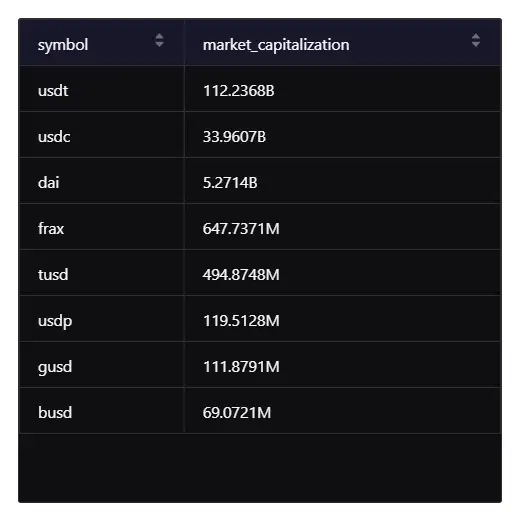The stablecoin market has reached a brand new benchmark, with its general capitalization rising to $165 billion. This comeback follows a restoration approaching the $180 billion excessive seen previous to the Terra/Luna occasion. Such a rise within the worth of stablecoins coincides with any upcoming bullish tendencies which may occur on Bitcoin and customarily all through all crypto.
A spread of things, together with rising use for buying and selling stablecoins, new integrations with DeFi protocols, and safe-haven belongings throughout risky market climates, has pushed this development. Demand for stablecoins has exploded, with an increasing number of merchants & traders trying to hedge in opposition to the risky nature of crypto costs.
Stablecoins are additionally broadly used for liquidity administration, with stablecoin pairs accounting for over 80% of each day crypto buying and selling quantity. Cross-border funds and remittances are some use instances which have helped associations broaden their adoption, primarily in areas with insufficient native currencies.

As a result of their unregulated use, digital money, together with stablecoins and crypto-assets, poses manifold dangers. This digital money can result in systemic dangers similar to leverage and liquidity mismatches, inflicting market disruptions. Lack of regulation may also result in client hurt, fraud, and prison actions like cash laundering and terrorist financing.
As these digital belongings grow to be extra interlinked with conventional monetary methods, the potential for contagion results will increase. Robust regulation is crucial to keep away from large-scale monetary crises. The Monetary Stability Board and the Worldwide Financial Fund emphasize the necessity for complete worldwide requirements to handle these dangers with out stifling innovation.
Regulatory Compliance and the Way forward for Stablecoins
International regulators additionally need elevated oversight on stablecoin initiatives to make sure monetary stability, market integrity, and, in the long run, client safety. Stablecoin issuers have solely just lately grow to be topic to broad worldwide requirements, together with the rules from the Monetary Stability Board (FSB) in July 2023 and people printed by the Basel Committee on Banking Supervision (BCBS) in December 2022 that set up governance expectations, threat administration necessities, and reserve asset disclosure for stablecoin issuers.
They’re constructing on earlier steerage outlined within the Committee on Funds and Market Infrastructures (CPMI) and the Worldwide Group of Securities Commissions’ rules for addressing monetary market infrastructures which can be systemically necessary, similar to stablecoins.
This interprets into strong governance constructions which can be a part of the regulatory frameworks in most jurisdictions, requiring stablecoin issuers to have prime administration with a monitor document and repute power adequate for dealing with these dangers. Furthermore, these frameworks require the establishing of sturdy operational threat administration methods to forestall cyber safety threats and anti-money laundering (AML) points, in addition to defend shoppers/traders.
“Stablecoins should still be unregulated or frivolously regulated,” mentioned Johannes Ehrentraud, Senior Advisor on the FSI. There isn’t a globally harmonized rule and no worldwide rule.” Ehrentraud went on to debate regulating and supervising crypto, stablecoins, and tokenized belongings.
Reserve asset administration is crucial to stablecoins’ stability and reliability. It have to be topic to strong insurance policies similar to these regarding credit score threat, liquidity threat, or dangers associated to exposures in relation to different holdings. But, concerning stablecoins’ reserve belongings, transparency shouldn’t be uniform amongst jurisdictions—an element which will contribute to which sorts are categorised as roughly steady.
International Development Picks Up Stablecoins
Whereas the stablecoin market is forecast to have a $2.8 trillion valuation by 2028, regulators are starting to hone their regulation frameworks so as to keep caught up with innovation whereas defending systemic dangers for monetary stability inside their economic system. It’s crucial that as stablecoins take a extra important foothold within the financial panorama, they be underpinned by transparency and strict compliance with laws to make sure belief. In line with this development, the Financial institution of England (BoE) is refining its cash and funds technique by growing proofs-of-concept on Distributed Ledger Know-how (DLT) in addition to exploring potential wholesale Central Financial institution Digital Currencies (wCBDCs).
Even because the BOE adapts to assist “a contemporary, progressive and dynamic U.Ok. economic system,” Governor Andrew Bailey mentioned that cash should stay a supply of confidence even when shoppers transfer additional in the direction of digital funds or non-public foreign money tokens instead of paper banknotes. These developments align with the significance of stablecoins in cross-border transactions and underscore a rising necessity for regulatory frameworks that stability stability and innovation amidst an ever-changing monetary ecosystem, as emphasised by Ripple introducing RLUSD, its U.S. dollar-backed stablecoin to XRP Ledger.

